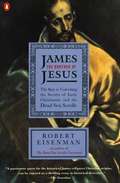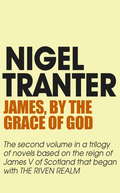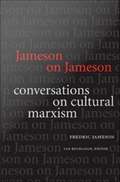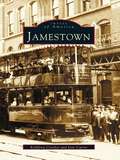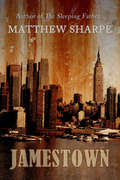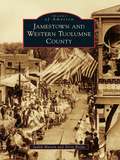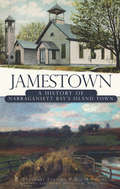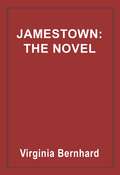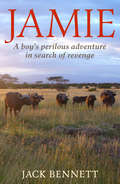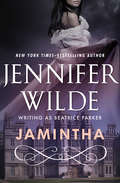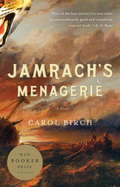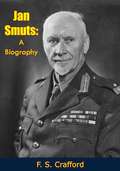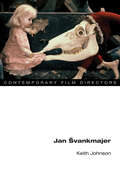- Table View
- List View
James Z. George: Mississippi’s Great Commoner
by Timothy B. Smith“When the Mississippi school boy is asked who is called the ‘Great Commoner’ of public life in his state," wrote Mississippi’s premier historian Dunbar Rowland in 1901, “he will unhesitatingly answer James Z. George.” While George’s prominence, along with his white supremacist views, have decreased through the decades since then, many modern historians still view him as a supremely important Mississippian, with one writing that George (1826–1897) was “Mississippi's most important Democratic leader in the late nineteenth century.” Certainly, the Mexican War veteran, prominent lawyer and planter, Civil War officer, Reconstruction leader, state Supreme Court chief justice, and Mississippi’s longest-serving United States senator to that time deserves a full biography. And George’s importance was greater than just on the state level as other southerners copied his tactics to secure white supremacy in their own states. That James Z. George has never had a full, academic biography is inexplicable. James Z. George: Mississippi’s Great Commoner seeks to rectify the lack of attention to George’s life. In doing so, this volume utilizes numerous sources, never or only slightly used, primarily a large collection of George’s letters held by his descendants and never used by historians. Such wonderful sources allow a glimpse not only into the life and times of James Z. George, but perhaps more importantly an exploration of the man himself, his traits, personality, and ideas. The result is a picture of an extremely commonplace individual on the surface, but an exceptionally complicated man underneath. James Z. George: Mississippi’s Great Commoner will bring this important Mississippi leader of the nineteenth century back into the minds of twenty-first-century Mississippians.
James and Dolley Madison: America's First Power Couple
by Bruce ChadwickThis revealing new portrait of James and Dolley Madison introduces the reader to America's first power couple. Using recently uncovered troves of letters at the University of Virginia, among other sources, historian Bruce Chadwickhas been able to reconstruct the details of the Madisons' personal and political lives. Chadwick argues that Madison was not a boring, average president, as other historians have characterized him, but a vibrant, tough leader-and a very successful commander in chief in the War of 1812. He contends that Madison, the architect of the Constitution, owed much of his success to the political savvy of his charismatic, much younger wife, whose parties and backdoor politicking make for remarkable stories. And Dolley, through her many social skills, created the dynamic role of First Lady that we know today. Despite their glamorous lifestyle, behind the scenes, the Madisons struggled with family drama: James and Dolley's constant funding of their charming but sociopathic son's misadventures ultimately led to their own financial ruin. Blending the personal and the political, this is a fascinating profile of a couple whose life together contributed so much to the future course of our nation.
James and Nora
by Edna O'BrienIt was June 10th, Barnacle Day. He saw her in Nassau Street and they stopped to talk. She thought his blue eyes were those of a Norseman. He was twenty-two, and she, Nora Barnacle, was twenty and employed as a chambermaid in Finn's Hotel. They agreed to meet on June 14th, outside No. 1 Merrion Square, the home of Sir William Wilde, but Nora did not turn up. After a dejected letter from Joyce they met on June 16th, a date which came to be immortalized in literature as Bloomsday.Edna O'Brien paints a miniature portrait of an artist, idealist, insurgent and filled with a secret loneliness. In Nora, he was to find accomplice, collaborator and muse. For all their sexual escalations, Joyce considered their relationship 'a kind of sacrament'. Their life was one of wandering, emotional upheaval and poverty. It was also one that was binding and mysterious, and defied all the mores of intimacy.In prose brimming with life and energy, Edna O'Brien resurrects a relationship of magnificent intensity on the page, and in doing so shows herself to be touched by the genius of the writer she loves above all others.
James the Brother of Jesus
by Robert H. EisenmanJames was a vegetarian, wore only linen clothing, bathed daily at dawn in cold water, and was a life-long Nazirite. In this profound and provocative work of scholarly detection, eminent biblical scholar Robert Eisenman introduces a startling theory about the identity of James--the brother of Jesus, who was almost entirely marginalized in the New Testament. Drawing on long-overlooked early Church texts and the Dead Sea Scrolls, Eisenman reveals in this groundbreaking exploration that James, not Peter, was the real successor to the movement we now call "Christianity." In an argument with enormous implications, Eisenman identifies Paul as deeply compromised by Roman contacts. James is presented as not simply the leader of Christianity of his day, but the popular Jewish leader of his time, whose death triggered the Uprising against Rome--a fact that creative rewriting of early Church documents has obscured. Eisenman reveals that characters such as "Judas Iscariot" and "the Apostle James" did not exist as such. In delineating the deliberate falsifications in New Testament dcouments, Eisenman shows how--as James was written out--anti-Semitism was written in. By rescuing James from the oblivion into which he was cast, the final conclusion of James the Brother of Jesus is, in the words of The Jerusalem Post, "apocalyptic" --who and whatever James was, so was Jesus.
James the Brother of Jesus: The Key to Unlocking the Secrets of Early Christianity and the Dead Sea Scrolls
by Robert H. EisenmanJames was a vegetarian, wore only linen clothing, bathed daily at dawn in cold water, and was a life-long Nazirite. In this profound and provocative work of scholarly detection, eminent biblical scholar Robert Eisenman introduces a startling theory about the identity of James-the brother of Jesus, who was almost entirely marginalized in the New Testament.Drawing on long-overlooked early Church texts and the Dead Sea Scrolls, Eisenman reveals in this groundbreaking exploration that James, not Peter, was the real successor to the movement we now call "Christianity." In an argument with enormous implications, Eisenman identifies Paul as deeply compromised by Roman contacts. James is presented as not simply the leader of Christianity of his day, but the popular Jewish leader of his time, whose death triggered the Uprising against Rome-a fact that creative rewriting of early Church documents has obscured.Eisenman reveals that characters such as "Judas Iscariot" and "the Apostle James" did not exist as such. In delineating the deliberate falsifications in New Testament dcouments, Eisenman shows how-as James was written out-anti-Semitism was written in. By rescuing James from the oblivion into which he was cast, the final conclusion of James the Brother of Jesus is, in the words of The Jerusalem Post, "apocalyptic" -who and whatever James was, so was Jesus.
James, By the Grace of God: James V Trilogy 2
by Nigel TranterIn the wake of the Battle of Flodden, Scotland was ruled in name only. The boy king, James V was at the mercy of ambitous rival factions, and beyond them, the ever-watchful, looming presence of Henry VIII of England. Escaping from the clutches of the power-hungry Earl of Angus, his most effective guides were to be two old friends, David Lindsay and David Beaton. But, impetuous and hot-blooded, James was more interested in wine and women than affairs of state, and his royal advisers faced a mighty task as they helped the king attain his regal status in a land full of treachery and danger. 'Through his imaginative dialogue, he provides a voice for Scotland's heroes' Scotland on Sunday
James, By the Grace of God: James V Trilogy 2 (The\james V Trilogy #Bks. 1-3)
by Nigel TranterIn the wake of the Battle of Flodden, Scotland was ruled in name only. The boy king, James V was at the mercy of ambitous rival factions, and beyond them, the ever-watchful, looming presence of Henry VIII of England. Escaping from the clutches of the power-hungry Earl of Angus, his most effective guides were to be two old friends, David Lindsay and David Beaton. But, impetuous and hot-blooded, James was more interested in wine and women than affairs of state, and his royal advisers faced a mighty task as they helped the king attain his regal status in a land full of treachery and danger. 'Through his imaginative dialogue, he provides a voice for Scotland's heroes' Scotland on Sunday
James: A Letter to the Scattered
by Earnest GrahamAn ancient letter that inspired deeds bravery and compassion in millions of lives.<P><P> In James: A Letter to the Scattered, Earnest Graham's dramatic illustrations follow women and men around the globe and through time. Follow hunted Christians into Roman catacombs, accompany errands of mercy in modern hospital corridors, see courage and kindness amidst the carnage of the Thirty Years' War, witness the fight for justice in 19th-century Mexico, and march beside protestors in 1960s Alabama.<P> A Letter to the Scattered, the first in a series of graphic novels from Olive Branch Books, brings the ancient wisdom of the Epistle of James to a new audience.<P> Advisory: Bookshare has learned that this book offers only partial accessibility. We have kept it in the collection because it is useful for some of our members. To explore further access options with us, please contact us through the Book Quality link on the right sidebar. Benetech is actively working on projects to improve accessibility issues such as these.
Jameson on Jameson: Conversations on Cultural Marxism
by Ian BuchananFredric Jameson is one of the most influential literary and cultural critics writing today. He is a theoretical innovator whose ideas about the intersections of politics and culture have reshaped the critical landscape across the humanities and social sciences. Bringing together ten interviews conducted between 1982 and 2005, Jameson on Jameson is a compellingly candid introduction to his thought for those new to it, and a rich source of illumination and clarification for those seeking deeper understanding. Jameson discusses his intellectual and political preoccupations, most prominently his commitment to Marxism as a way of critiquing capitalism and the culture it has engendered. He explains many of his key concepts, including postmodernism, the dialectic, metacommentary, the political unconscious, the utopian, cognitive mapping, and spatialization. Jameson on Jameson displays Jameson's extraordinary grasp of contemporary culture--architecture, art, cinema, literature, philosophy, politics, psychoanalysis, and urban geography--as well as the challenge that the geographic reach of his thinking poses to the Eurocentricity of the West. Conducted by accomplished scholars from United States, Egypt, Korea, China, Sweden, and England, the interviews elicit Jameson's reflections on the broad international significance of his ideas and their applicability and implications in different cultural and political contexts, including the present phase of globalization. The volume includes an introduction by Jameson and a comprehensive bibliography of his publications in all languages. Interviewers Mona Abousenna Abbas Al-Tonsi Srinivas Aravamudan Jonathan Culler Sara Danius Leonard Green Sabry Hafez Stuart Hall Stefan Jonsson Ranjana Khanna Richard Klein Horacio Machin Paik Nak-chung Michael Speaks Anders Stephanson Xudong Zhang
Jamestown
by Jane Currie Kathleen CrockerCity founder James Prendergast and other industrious pioneers were drawn to the outlet of Chautauqua Lake in southwestern New York State because of its abundant waterpower and virgin forests. The skills of these settlers, coupled with the area's natural resources, led to the emergence of industrial Jamestown, known worldwide for its diverse manufacture of quality products, including furniture, metal, and textiles. The authors have chosen more than two hundred vintage images based on historic markers for Jamestown. Thorough research and oral histories reveal contributions made by trailblazing immigrants, philanthropic families, diverse ethnic groups, earnest businessmen, and three hometown notables who achieved global fame: Lucille Ball, Roger Tory Peterson, and Robert H. Jackson.
Jamestown
by Matthew SharpeJamestown chronicles a group of "settlers” (more like survivors) from the ravaged island of Manhattan, departing just as the Chrysler Building has mysteriously plummeted to the earth. This ragged band is heading down what’s left of I-95 in a half-school bus, half-Millennium Falcon. Their goal is to establish an outpost in southern Virginia, find oil, and exploit the Indians controlling the area. Based on actual accounts of the Jamestown settlement from 1607 to 1617, Jamestown features historical characters including John Smith, Pocahontas, and others enacting an imaginative re-version of life in the pioneer colony. In this retelling, Pocahontas’s father Powhatan is half-Falstaff, half-Henry V, while his consigliere is a psychiatrist named Sidney Feingold. John Martin gradually loses body parts in a series of violent encounters, and John Smith is a ruthless and pragmatic redhead continually undermining the aristocratic leadership. Communication is by text-messaging, IMing, and, ultimately, telepathy. Punctuated by jokes, rhymes, "rim shot” dialogue, and bloody black-comic tableaux, Jamestown is a trenchant commentary on America's past and present that confirms Matthew Sharpe’s status as a major talent in contemporary fiction.
Jamestown Furniture Industry, The: History in Wood, 1816-1920
by Clarence CarlsonWhile all but gone today, Jamestown's furniture industry was once the second-largest producer of furniture in the United States. Manufacturing boomed from 1816, when William Breed and Royal Keyes opened their shops, to the 1920s, when Jamestown was still one of the top wood furniture producers in the country. In the nineteenth century, the thriving railroad industry allowed Jamestown's quality creations to be distributed nationwide. After the Civil War, an influx of Swedish immigrants brought their craftsmanship and skills to Jamestown, forming Morgan Manufacturing, Empire Furniture Company and many others. Then, their pieces were valued for quality and durability; today, they're coveted by collectors as beautiful antiques. Local expert Clarence Carlson uncovers the fascinating story of Jamestown furniture.
Jamestown and Western Tuolumne County
by Judith Marvin Terry BrejlaThe hamlet of Jamestown dates to the early Gold Rush. Discovered in August 1848, the Woods Creek placers at Jamestown eventually yielded millions of dollars in gold. When the easily mined placer gold gave out, the town remained a trade and supply depot for mining higher in the foothills, with a prime location on the roads from the Central Valley. From the 1890s to 1910s, the hard-rock mining era, known as the second Gold Rush, granted new life to the town, surrounded as it is by the Mother Lode itself. But it was the coming of the Sierra Railway in 1897 that cemented Jamestown's status, transporting the bounty of Tuolumne County's natural resources, including minerals, cattle, produce, and lumber, to the waiting markets in California and across the country. The railroad also facilitated three major dam construction projects from the 1910s to the 1940s and brought many film crews to the area.
Jamestown, 1607
by Michael L. CooperIn May of 1607, the first English colony on American soil was established in Virginia, at Jamestown. The Englishmen who founded Jamestown knew they faced hostile Native Americans and the challenge of surviving in the wilderness. But their dreams of discovering gold, founding a great city, and conquering new lands were stronger than their fears.
Jamestown: A History of Narragansett Bay's Island Town
by Sue Maden Rosemary Enright Jamestown Historical SocietyJamestown, Rhode Island's history has been formed--both for good and ill--by its geography. The town officially encompasses three islands in Narragansett Bay--Conanicut, Dutch and Gould--plus a number of small islets known as "dumplings." Jamestown was part of the larger world when merchants and travelers used the common roadway of the bay. As the speed of transportation on land increased, that same bay isolated the town. Reliable ferry transport fostered the growth of a low-key resort, and the bridges that followed moved the community from resort to suburb. The changes have left Jamestowners torn. Some look back nostalgically at the ferries and the solitude they allowed, while others look forward to a vibrant village and grand suburban homes. Still, whether one is reviewing Jamestown's past or anticipating its future, the constraints of its geography remain forever unchanged.
Jamestown: New World Adventure (Adventures in Colonial America)
by James KnightTwo English children are told the story of their grandfather's experiences as one of the original Jamestown colonists of 1607. This volume is part of the Adventures in Colonial America series.
Jamestown: The Novel
by Virginia Purinton BernhardIn 2013 archaeologists in Jamestown, Virginia discovered the grave of a fourteen-year-old girl who had died there 400 years ago. Her bones bore the unmistakable marks of cannibalism: proof that in the terrible "Starving Time" in the winter of 1609-1610, some of the desperate colonists who ate rats, mice, shoe leather to stay alive, also ate human flesh. Their story is told in this extraordinary historical novel. Based on the actual history of Virginia, this is a tale of savagery and squalor, love and betrayal, of unquenchable hope and gritty courage. Many of the characters are known from colonial records: John Smith and Pocahontas (the site of her famous "rescue" of Smith has recently been discovered); the shrewd Powhatan, father of Pocahontas and ruler of 15,000 Indians; Temperance and George Yardley, a couple separated by a shipwreck and reunited with unforeseen results; and others who made the perilous voyage to Virginia. There a determined company of settlers struggled to survive in an unfamiliar land. Surrounded by natives who did not welcome them, they battled grim adversity and human frailty, deceit, and treachery to plant the first successful English colony in the New World.By the time the Mayflower landed at Plymouth in 1620, English ships had already carried more than three thousand people to Jamestown, Virginia--and nearly two thousand of them had died there.Their story is the story of America's beginnings. Virginia Bernhard is Professor Emerita of History at the University ofSt. Thomas. She is the author of A TALE OF TWO COLONIES: WHAT REALLY HAPPENED IN VIRGINIA AND BERMUDA? (2011) and other works on early American history. She and her husband live in Houston, Texas.A complex tale of courage, treachery, cultural conflict, administrative bungling and desperate choices.PUBLISHERS WEEKLYColonial Jamestown springs from the pages. An absorbing telling that blends fact and fiction.NEW YORK DAILY NEWSCombines Bernhard's expertise as an American history professor with a vivid, sure prose style to produce a rich tale of suffering and triumph in 1600s America.KIRKUS REVIEWS
Jamie
by Jack BennettJamie, first published in 1963, is a moving novel set in South Africa and centered on 12-year-old Jamie Carson. The region is experiencing a severe drought, forcing wild animals to approach farmsteads in their search for water. Sadly, Jamie’s father is killed by a wild buffalo, and Jamie is determined to seek revenge. The boy receives sympathy from the adults, but they offer no help in his securing a rifle and ammunition, as he is determined to find and kill the rogue animal. He is eventually able to buy a poorly made gun and several bullets from a native African, and goes into the bush accompanied by a native boy to seek his prey. An excellent book for both teenagers and adults, Jamie evokes a strong sense of place, and the reader will feel a part of the hot dry landscape as Jamie wanders the scrubland in search of the buffalo.
Jamintha
by Jennifer WildeA woman travels to a remote island on the edge of the moors to unravel the truth about a past she can&’t remember in master of suspense Jennifer Wilde&’s spellbinding Gothic romance Jane Danver has no memory of her first seven years at her family&’s ancestral estate on the isolated island of Danmoor. Now eighteen, she has been summoned home by her guardian to the place that still lives in her nightmares and fills her with terror. Tyrannical Charles Danver instills fear in the local villagers. His ne&’er-do-well son, Brence, both frightens and attracts Jane, and the mysterious French housekeeper spies on her. Jane has only one ally: mysterious Jamintha, who believes that something is dangerously amiss at the mansion. As Jane&’s memory starts to return—with the help of handsome, dedicated Dr. Gavin Clark—she journeys back to a time and place that have left their mark on her forever. But deadly peril waits within the ruins of the house&’s west wing—an evil that could keep Jane from ever leaving Danver Hall again.
Jamrach's Menagerie
by Carol BirchA thrilling and powerful novel about a young boy lured to sea by the promise of adventure and reward, with echoes of Great Expectations, Moby-Dick, and The Voyage of the Narwhal. Jamrach's Menagerie tells the story of a nineteenth-century street urchin named Jaffy Brown. Following an incident with an escaped tiger, Jaffy goes to work for Mr. Charles Jamrach, the famed importer of exotic animals, alongside Tim, a good but sometimes spitefully competitive boy. Thus begins a long, close friendship fraught with ambiguity and rivalry. Mr. Jamrach recruits the two boys to capture a fabled dragon during the course of a three-year whaling expedition. Onboard, Jaffy and Tim enjoy the rough brotherhood of sailors and the brutal art of whale hunting. They even succeed in catching the reptilian beast. But when the ship's whaling venture falls short of expectations, the crew begins to regard the dragon--seething with feral power in its cage--as bad luck, a feeling that is cruelly reinforced when a violent storm sinks the ship. Drifting across an increasingly hallucinatory ocean, the survivors, including Jaffy and Tim, are forced to confront their own place in the animal kingdom. Masterfully told, wildly atmospheric, and thundering with tension, Jamrach's Menagerie is a truly haunting novel about friendship, sacrifice, and survival.
Jan Gösta Waldenström and His World: The Life and Work of a Giant in Science, Medicine and Humanity (Springer Biographies)
by Frank WollheimJan Waldenström (1906-1996) was the leading Swedish internist of the twentieth century. The first chapter of the book presents his remarkable family including five generations of physicians. Born in Stockholm, we follow JW to medical school at Uppsala University during 1924–33. In 1934–5, he spent a year in the laboratory of Nobel Laureate Hans Fischer in Munich. In 1937, he defended a landmark thesis on acute intermittent porphyria. As “Docent” (assistant professor) in Uppsala, he discovered two new diseases in 1943. In 1944–5, he spent 7 months in the US commissioned by the Swedish Health Board. This started friendships with leading colleagues and scientists. With time, JW fostered a worldwide network of contacts and became a most influential international star. But this was just the beginning. The book follows Waldenström's remarkable career including his description of chronic active hepatitis as a new disease, his introduction of nuclear medicine in Sweden, his pioneering of the concept of the concept of poly- and monoclonal gammopathies, and many more highly significant achievements. His legacy is emphasized by Waldenström lectures, Waldenström Prizes, and by the International Waldenström’s Macroglobulinemia Foundation, IWMF, and the Bing Center for Waldenström’s macroglobulinemia at the Dana Farber Institute of Cancer Institute of the Harvard University in Boston. And now, not least, by this comprehensive biography.
Jan Hendrik Oort: Master of the Galactic System (Astrophysics and Space Science Library #459)
by Pieter C. van der KruitThis book is the first thorough and overdue biography of one of the giants of science in the twentieth century, Jan Hendrik Oort. His fundamental contributions had a lasting effect on the development of our insight and a profound influence on the international organization and cooperation in his area of science and on the efforts and contribution of his native country.This book aims at describing Oort's life and works in the context of the development of his branch of science and as a tribute to a great scientist in a broader sense. The astronomer Jan Hendrik Oort from the Netherlands was founder of studies of the structure and dynamics of the Milky Way Galaxy, initiator of radioastronomy and the European Southern Observatory, and an important contributor to many areas of astronomy, from the study of comets to the universe on the largest scales.
Jan Patočka and the Heritage of Phenomenology
by Ivan Chvatík Erika AbramsWhereas for the wider public Jan Patocka is known mainly as a defender of human rights and one of the first spokespersons of Charter 77, who died in Prague several days after long interrogations by secret police of the Communist regime, the international philosophical community sees in him an important and inspiring thinker, who in an original way elaborated the great impulses of European thought - mainly Husserl's phenomenology and Heidegger's philosophy of existence. Patocka also reflected on history and the future of humanity in a globalized world and laid the foundations of an original philosophy of history. His work is a subject of lively philosophical discussion especially in French and German-speaking countries, and recently also in Spanish-speaking, in U.S.A., and in the Far East. Scholars from around the world who are interested in the philosophy of Jan Patocka gathered in Prague to commemorate his centenary and the thirtieth anniversary of his death. The conference explored the significance of his work and its continuing influence on contemporary philosophy. The volume presents selected papers from the conference in English language.
Jan Smuts: A Biography
by F. S. Crafford‘A just biography of an important figure—political philosopher, soldier in three wars, scientist, statesman—Jan Smuts, who has played a long and decisive role in the formation and consolidation of South Africa. Masterful, energetic, intolerant, often highhanded, Smuts has never been a popular leader, but never once did he deviate from his conception of a united South Africa within the British Empire. Before his Premiership and after, he was to fight steadily against the opposition, the Nationalists, who demanded complete severance from Britain. Other problems of the Indians, of labor rebellion, of industrial unrest, objectively presented. During the First World War, his ruthless leadership in action in East Africa; his important part in world affairs as representative in the British War Cabinet; and later his plan for the League of Nations. He fell from power in 1924, as the anti-British Hertzog came in; he was recalled at 70 to head his country at war for the third time, which he has accomplished with equal severity and decisiveness.‘Sound, factual biography…’ (Kirkus)
Jan Svankmajer (Contemporary Film Directors)
by Keith Leslie JohnsonJan Svankmajer enjoys a curious sort of anti-reputation: he is famous for being obscure. Unapologetically surrealist, Svankmajer draws on the traditions and techniques of stop-motion animation, collage, montage, puppetry, and clay to craft bizarre filmscapes. If these creative choices are off-putting to some, they have nonetheless won the Czech filmmaker recognition as a visionary animator. Keith Leslie Johnson explores Svankmajer's work as a cinema that spawns new and weird life forms ”hybrids of machine, animal, and non-organic materials like stone and dust. Johnson's ambitious approach unlocks access to the director's world, a place governed by a single, uncanny order of being where all things are at once animated and inert. For Svankmajer, everything is at stake in every aspect of life, whether that life takes the form of an object, creature, or human. Sexuality, social bonds, religious longings ”all get recapitulated on the stage of inanimate things. In Johnson's view, Svankmajer stands as the proponent of a biopolitical, ethical, and ecological outlook that implores us to reprogram our relationship with the vital matter all around us, including ourselves and our bodies.



